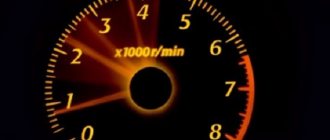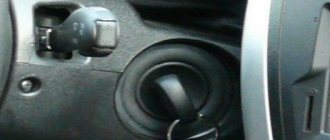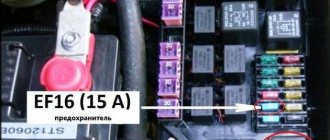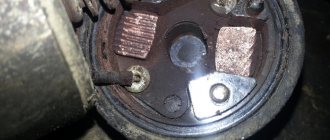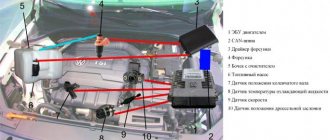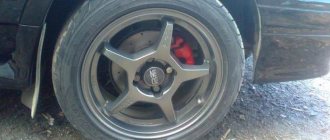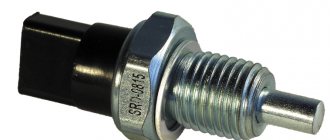The wiring diagram for hatchbacks 2112 is a unique thing in itself. In order for voltage to appear on the solenoid relay, the following parts must be in good working order: the ignition switch, the ECU unit and two more relays - the main and additional ones. Some cars do not have an additional relay, which can be considered good luck. But, if when you turn the key on a VAZ-2112 the starter does not turn, then the fault must be looked for in the wiring. A broken immobilizer code can also cause problems. The last malfunction can be cured by replacing the ECU or disabling the immobilizer. Well, let's look at something simpler.
The reader will be surprised, but there will be more than one scheme here. The most difficult option is shown below.
Scheme with an additional starter relay Please note: relay K2 is not at all “unloading”. A significant current flows through the lock contacts, and relay K2 can be called “blocking”: when it does not work, the starter does not turn. Why is this necessary, think for yourself.
If an attacker closes the contacts in the lock, he will not only be unable to start the engine, but also not use the starter. That is, the hijacker will not drain our battery. The circuit shown above is used with 1.6 liter injection engines. There may be another option - a simpler one.
Circuit without additional relay There is no blocking relay here. The current flows to the solenoid relay from pin 50. A simple version of the circuit is typical for cars from early years of production. Which applies to the entire “Ten” family, including hatchbacks. That is, an interesting combination occurs: the model is VAZ-2112, and the starter will turn even in the absence of all relays and ECUs!
Failure when pressing the gas pedal: causes and solutions to the problem
Failure when pressing the gas pedal or accelerator pedal is a problem that is rare in modern cars, but a common occurrence in VAZ cars. The problem is that pressing the pedal has no effect. And after a few seconds there is a jerk, the car jerks. A serviceable engine responds quickly to pressing the gas pedal.
If you find such a problem in your car, do not put off fixing the problem until later. You can diagnose the problem yourself, but the best option would be to contact a car service. Mechanics with extensive experience and modern equipment will quickly find the cause of the gas pedal failure.
In winter, especially on slippery roads, sudden acceleration of the car can turn into a serious problem. In case of loss of control, an emergency situation may occur.
Failure while overtaking a passing vehicle on the road does not bode well. You will have to apply sharp braking and return to your lane, but there may be another car there.
Balancing required
Runout on the steering wheel and car body with increasing speed is inevitable if the wheels are not balanced. The uneven distribution of mass relative to the center of the wheel rim leads to such consequences. The action of multidirectional centrifugal forces leads to the appearance of multi-frequency oscillations, which are felt as a beating in the car interior.
The problem may manifest itself in the following cases:
- Installing new tires. Replacing tires on rims or putting new rims on old tires must be accompanied by balancing. Even for the manufacturer, achieving ideal weight distribution and geometric parameters seems to be an extremely difficult task.
- Loss of old balancing weights. This is especially true for light alloy wheels, where the weights are glued to the inside of the wheel. Let us remember that in the case of stamped rims, the weights are placed in the outer shoulder of the rim.
- Deformation of the rubber or disk due to falling into a deep pothole, a strong impact with the curb and other similar obstacles.
- Natural imbalance. During operation, any wheel will lose its established balance. It is recommended to carry out scheduled balancing every 15-20 thousand km.
Another breeding ground for imbalance is often the constant velocity joint. It serves as a device for the movable articulation of the drive shaft and gearbox, which allows the transmission of torque in different planes (internal CV joint). At the other end of the drive shaft for articulation with the hub (outer CV joint).
Most often, the cause of vibrations lies precisely in the internal hinge. In the case of a tripod-type design, wear out of the rollers is observed. In especially severe cases, the bearing may even “fall apart”. It is also possible to produce a tripod glass.
A similar malfunction can be caused by a torn boot, which can no longer protect against dirt and dust flying from under the wheels. Therefore, periodically check the integrity of the CV joint boots.
Drive shaft
It will be worth mentioning that a car with a drive of irregular geometric shape is guaranteed to experience vibration when accelerating. A bent drive shaft will not only rotate around its axis, but also provoke parasitic centrifugal forces. As a result, the car will receive additional vibrations as it accelerates.
Cardan
The problem is typical for cars with rear-wheel drive and all-wheel drive. Wear of the cardan joint leads to vibration during acceleration. If you encounter a similar problem, pay attention to the following elements:
- crosses;
- suspension bearing;
- directly to the driveshaft. An unbalanced cardan will lead not only to beating, but also to subsequent destruction of the joints.
There were cases when the cause of runout at speed was play in the gearbox shank. This also needs to be paid attention to.
What are failures?
Failure when pressing the gas pedal lies in the improper reaction of the engine to this. Thus, when trying to accelerate, the engine does not gain the required speed.
This leads to a drop in speed. It manifests itself with gradual and sudden acceleration. Dips appear when you press the gas pedal in different ways:
- Short-term failures. There is no response to pressing for a couple of seconds.
- Lingering failures. The engine loses speed for 4 to 10 seconds, and it is possible that the car will stall.
- Jerks. Dips up to 1 or 2 seconds. The car seems to be “twitching”.
- A series of jerks. The engine either increases speed or slows down, although the pedal is in the same position.
- The car jerks. Consists of a series of protracted failures.
How much does it cost to replace a starter?
Beginning car enthusiasts often have questions after visiting a parts store. Most often they are interested in why relays have very different prices. First of all, it is worth remembering that spare parts for the VAZ-2110 are manufactured not only by domestic factories, so you can find relays under brands such as BOSCH or Tomahawk. They are more expensive than those produced in Russia. At the same time, domestic ones have a better price-quality ratio. Brands such as VIS or Torgmash will cost you much less.
If you prefer to install original components from AvtoVAZ (often in stores they are labeled “made in Tolyatti”), then the relay will cost you about 1,000 rubles, and the entire starter – 5,000. Domestic manufacturers of spare parts can offer you more budget options. The price may be half as low, but the quality is not always worthy. Imported analogues, on the contrary, are twice as expensive, so a starter from BOSCH can be found for 10 thousand rubles, a relay will cost about 2,000.
HAVE YOU FOUND YOUR REASON?
Often, failures occur due to a breakdown of the power system. After pressing the gas pedal, the power system increases the volume of fuel supplied to the cylinders. Breakage causes a change in these proportions. Those. The motor just can't do its job.
In addition, it is possible that there may be a breakdown in the ignition system. It occurs much less frequently. It's either spark plugs or ignition wires. The spark plugs must be removed and checked. The presence of carbon deposits or too clean spark plugs indicate a rich or lean fuel mixture, respectively. This indicates that the ignition system is adjusted incorrectly.
To ensure that the fuel mixture ignites at the right time, read the article on how to set the ignition correctly.
Is it safe to drive with a misfire?
If a leak occurs, the air-fuel mixture entering the engine will come out unburnt. Modern cars have a catalytic converter that reduces emissions from the car. The catalyst can heat up to 600 degrees during operation.
And what happens when the unburnt air-fuel mixture gets into it? That's right, it will explode inside the catalyst. Explosions inside the catalytic converter can damage it. And a new catalyst is not a cheap pleasure.
In addition, misfires can also damage other sensors in the engine, such as oxygen sensors. We would never recommend driving a vehicle with a misfire, especially over long distances. Short distances to a service station without stress on the engine are normal, but don't ignore gaps and continue driving.
Dips when pressing the gas pedal during acceleration
Determined using computer diagnostics or the steps described below:
- The first thing you need to do is inspect the spark plugs. To do this you need to remove them. The presence of carbon deposits on the spark plugs, poor contact with the wires, or an excessively lean or rich mixture lead to spark plug malfunctions.
- High voltage wires can also cause engine malfunction, as can ignition coils.
- The throttle needs to be checked. If it is clogged, this causes the engine to respond untimely when pressing the gas pedal.
- It is necessary to check the condition of the air, fuel and oil filters. They tend to get clogged, which worsens dynamics, increases fuel consumption and causes pedal failure. They need to be changed constantly, you can do it yourself, they are inexpensive and easy to install.
- The presence of errors in the ECU leads to failures.
- Clogged injectors. If necessary, replace or repair injectors.
The wires, as well as the rubber bands on them, should not be damaged and should not spark when the engine is running. If damage is found, this indicates that the engine is shaking and jerking begins. This may occur due to the age of the car, worn-out or low-quality spare parts, poor contact with the spark plugs, or due to the temperature of the engine.
The resistance of the coils and the temperature change together, as a result of which a gasoline car begins to jerk during acceleration. In diesel cars, jerking cannot be associated with the coils, since they are not present.
DIY mechanism repair and replacement
If the power unit does not start, it is necessary to repair the VAZ starter.
This procedure looks like this:
- First of all, you should disconnect the battery, and then disconnect the wires connected to the traction relay.
- Using a 13mm wrench, you will need to unscrew the nut that secures the positive contact of the cable connected from the battery to the starter assembly. The wire itself can then be dismantled.
- Next, you will need to unscrew the nuts that secure the mechanism to the clutch housing. To unscrew the nuts you will need a 15mm wrench.
- After completing these steps, the starter assembly can be removed. If you plan to replace it with a new one, then the replacement can be done at this stage. When replacing, you need to take into account the location of the wires connected to the starter; under no circumstances should they be mixed up. Therefore, before disconnecting the wires, it is advisable to mark them. If you do not want to change the mechanism, but plan to repair it, then you can start disassembling it.
- To disassemble, you will need a 10mm wrench; you can use it to unscrew the nut located on the relay and remove the wire connected to the starter.
- The relay screws that secure it to the starter assembly must be unscrewed using a size 8 wrench. Having done this, you can dismantle the relay.
- After removing the relay, you can see the gasket, which is located between the front cover of the mechanism and the relay itself. It should also be removed for disassembly, but when dismantling it is worth paying attention to its condition. If you see that the sealing element is worn out and its quality is quite low, then it is better to replace this component.
- When the seal is dismantled, it will be necessary to remove the spring, as well as the anchor.
- The next step is to remove the parking stud nuts.
- After completing these steps, you can dismantle the mechanism from the studs with the anchor itself. After this, it is necessary to thoroughly clean the internal parts and components of the device. For proper repairs, you should diagnose the contacts, and also completely disassemble the brush assembly and check its condition. In general, the procedure for repairing a mechanism is quite complicated, so not every car enthusiast chooses this method - sometimes it is easier to simply replace the unit with a new one. In particular, this will be necessary if the repair process did not produce any results.
Photo gallery “We repair the device ourselves”
1. The nuts that need to be unscrewed are marked in red and blue, the wire is marked in green.
2. Red arrows indicate planetary gears.
3. To remove the solenoid relay, unscrew the two bolts.
Loading …
Dips when pressing the gas pedal at idle
Problems also occur at idle speed; of course, there will be fewer reasons. However, this is also a serious problem and cannot be ignored, because... The car will have difficulty starting and simply stall.
Troubleshooting is performed in the following order:
- The first thing to check is the spark plugs. If the spark plugs are faulty, they should be replaced. We recommend replacing all spark plugs at the same time. Buy spark plugs specifically for your engine. If necessary, adjust the gap; it should be 1 mm for 92 gasoline.
- The fuel filter and fuel pump diagnostics are checked. If a malfunction is identified, fix it.
- The breakdown may be in the idle speed sensor.
- Checking the injectors. If clogged, replacement or cleaning is necessary.
- Diagnostics of the ECU for errors.
- Checking the injector.
Dips when pressing the gas pedal - carburetor
As noted above, the problem occurs in VAZ 2107, 2106, 2109 cars that have a carburetor installed. Mainly problems with the fuel system. It will most likely be clogged. Therefore, to identify the cause, the fuel supply to the carburetor is checked.
As a result of clogging, the operation of the fuel pump decreases, and the carburetor begins to receive less fuel. As a result, the engine starts and idles without problems, but when pressed, failures occur.
If everything is fine with the fuel system, then the fault must be looked for in the carburetor. It is responsible for dosing the supplied fuel into the air flow. If there are violations, failure occurs. However, first you need to check for air leaks. The carburetor may become loose, allowing air to leak through the gap, making the mixture lean.
The filter mesh must also be checked. It is located in the inlet fitting of the pipeline that goes to the fuel pump. If it is contaminated, then this is a consequence of failures.
Dips when pressing the gas pedal on the carburetor:
Painfully banal
If the body vibrates when accelerating, you should not be upset and immediately count out a large amount for repairs. Below are some common and not so common cases that can cause discomfort when driving:
- Dirt or ice block stuck to the inner rim of the wheel rim. Diagnosing the adhesion of dirt is not difficult, since noticeable beating will occur only after off-road driving. In winter, every driver should be prepared for such troubles;
- Incorrect installation of brake and wheel discs. If the mating plane has not been cleared of contaminants or is deformed, this will cause an increase in vibration load during movement;
- discrepancy between the landing dimensions of the wheel rims. Each disk has its own installation parameters, violation of which can lead to imbalance. This mainly concerns disc bolt patterns;
- loose disk fastenings. This is the first thing to check when you notice runout in the steering wheel. The consequences of neglecting this advice can be very dire.
Dips when pressing the gas pedal - injector
To determine the reasons for the failure of the gas pedal of a raspberry with an injection engine, special equipment is needed, with the help of which diagnostics are carried out. Therefore, to detect a malfunction, you should definitely contact a car service in Moscow.
For the most part, jerking occurs when the fuel supply pressure is low or due to problems with the throttle position sensor.
Conclusion
- Ignition coils and bad spark plugs are the most common problem if you have a misfire.
- Intake leaks are a common problem if you have a trouble code related to the air-fuel mixture.
- If you have an air mixture fault code, always start checking there.
I hope you learned something and solved your misfire problems.
Previous post Idle air control (IAC) - how it works, malfunctions, symptoms, testing
Next entry Error P0339 - what it means, symptoms, causes, diagnosis, solution
The pedal falls when the car starts to move
All unpleasant sensations are most often associated with a delayed reaction of the motor to pressing the pedal. Engine stalling often occurs.
The shocks appear when the throttle valve opens, then the sensor gives a signal and the ECU determines at what time to switch from idle to load mode, as well as how much to increase the fuel supply through the injectors. If the pressure is not as high as we would like, and if the injection time is increased, then there will not be enough fuel to move the car.
Also, the cause of jerking may be problems with the electromechanical part of the unit and due to clogging with waste.
On which cars is this problem most common?
The problem with code P0335 can occur on different machines, but there are always statistics on which brands this error is more common. Here is a list of some of them:
- Alfa Romeo
- Audi
- BMW (BMW E53, E60)
- Chery
- Chevrolet (Chevrolet Aveo, Captiva, Cruz, Lacetti, Rezzo, Suburban, Epica)
- Chrysler
- Citroen (Citroen C4, C5, Jumper)
- Daewoo (Daewoo Matiz, Nexia)
- Dodge (Dodge Caliber, Caravan, Ram, Stratus)
- Fiat (Fiat Albea, Doblo, Ducato)
- Ford (Ford Mondeo, Ranger, Transit, Focus, Fusion)
- Geely (Gili Emgrand)
- Honda (Honda Jazz, SRV, Fit, Civic)
- Hyundai (Hyundai Accent, Getz, Porter, Santa Fe, Solaris, Sonata, Terracan, Tucson, Elantra, i30, i40, ix35)
- Infiniti (Infiniti fx35, fx37, fx45, qx56)
- Jeep (Jeep Wrangler)
- Kia (Kia Magentis, Optima, Rio, Sid, Sorento, Soul, Spectra, Sportage, Cerato)
- Land Rover (Land Rover Freelander)
- Lexus (Lexus lx570, is250, rx300, rx350)
- Mazda (Mazda 3, Mazda 6, Mazda cx7, Bongo, Demio)
- Mercedes (Mercedes Sprinter, s320, w140, w211)
- Mitsubishi (Mitsubishi Airtrek, Outlander, Galant, Karisma, Lancer, Pajero, Fuso, L200)
- Nissan (Nissan Hell, Almera, Altima, Armada, Bluebird, Wingroad, Beetle, Ixterra, Cabstar, Qashqai, Quest, Maxima, March, Micra, Murano, Navara, Note, Pathfinder, Primera, Pulsar, Sunny, Serena, Teana, Tiida , X-Trail)
- Opel (Opel Astra, Vectra, Zafira, Combo, Corsa, Meriva)
- Peugeot (Peugeot 206, 307, 308, 408, Boxer)
- Pontiac (Pontiac Montana)
- Porsche
- Renault (Renault Duster)
- Skoda (Skoda Octavia, Fabia)
- Ssangyong (Sanyeng Aktion, Kyron, Rexton)
- Subaru (Subaru Outback, Impreza, Legacy, Forester)
- Suzuki (Suzuki Vitara, Grand Vitara, Jimny, Liana, sx4)
- Toyota (Toyota Avensis, Camry, Corolla, Land Cruiser, Mark 2, Prado, Rav4, Highlander, Hilux)
- Volkswagen (Volkswagen Jetta)
- Volvo (Volvo s60)
- VAZ 2107, 2109, 21099, 2110, 2111, 2112, 2114, 2115
- GAZ Maxus (LDV Maxus)
- Gazelle Business, Next, ZMZ 405, UMZ 4216
- Lada Vesta, Granta, Kalina, Niva, Priora
- UAZ Bukhanka, Patriot, Hunter, ZMZ 409
With fault code P0335, you can sometimes encounter other errors. The most common are: P0016, P0017, P0018, P0019, P0122, P0300, P0322, P0336, P0337, P0338, P0339, P0340, P0342, P0344, P0350, P0385, P0386, P0387, P0388, P038 9, P0522, P0642, P1133 , P1335, P1693, P2122.
The pedal falls when the movement is set
The cause may be a faulty ignition. In this case, diagnostics and repair work are required.
You can try to fix the problem yourself:
- First, you need to look under the hood and inspect everything. Remove the key from the ignition and check whether the ignition coils are securely attached and seated on the spark plugs. Next, start the engine and listen to how it works.
- Replace spark plugs regardless of their condition and how long they last. Check the spark plugs - if they are damaged, engine repair is inevitable.
The gas pedal fails in a VW POLO sedan due to unstable operation of the damper position sensor, which is built into the cover itself. The engine idles intermittently, the engine power is reduced to a minimum - this all indicates that the sensor has failed.
The cover itself cannot be disassembled, so you will have to replace the entire throttle assembly.
Error classification
The difference in numbers at the end of the error codes allows you to identify the serial number of the cylinder in which the ignition sequence failed. That is, code p0301 shows that the misfire occurred in the first cylinder, p0302 in the second, and so on. Depending on the brand of engine and the number of cylinders in it, the code may even be designated p0306 or p0312.
Thus, error code p0300 is the initial error for any engine, indicating a violation of the ignition sequence in the cylinder block.
In what cases does the computer generate error p0300?
The car owner should know that error code p0300 will be recorded only in cases where ignition failures are detected in two or more cylinders at the same time. That is, the system does not consider a one-time misfire in one specific cylinder a violation, so it does not send a signal about this error to the dashboard.
It is important that with repeated passes, Check Engine with code p0300 is displayed on the instrument panel. If the system has accurately identified the source of the problem, the number of the “problem” cylinder will appear - for example, p0303.
DON'T POSTPONE YOUR CAR DIAGNOSIS FOR LATER!
If the failures do not stop, then you should definitely contact a specialist. They will be able to diagnose the computer control and check the fuel supply system and determine the location of the breakdown and carry out corrective measures. Most often, the cost of repairs is low. Therefore, the best advice would be not to do it yourself and entrust your car to professionals. This will be the most reasonable decision rather than wasting time, effort and nerves on troubleshooting yourself.
Didn't find the information you are looking for? on our forum.
